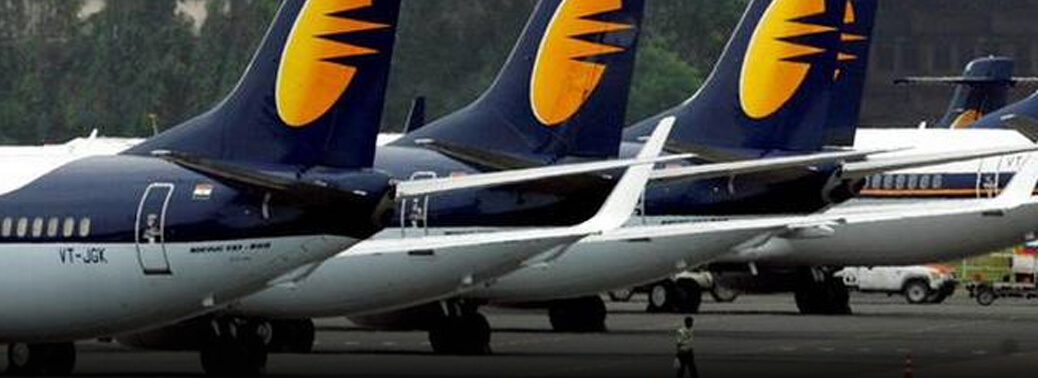JET SUSPENDS ALL FLIGHTS AFTER BANKS REFUSE TO RELEASE FUNDS
19, Apr 2019

Prelims level : Nil
Mains level : GS-III technology, economic development, bio diversity, security and disaster Management
Why in News:
- Jet Airways announced temporary suspension of all its international and domestic flights, with the last flight operating between Amritsar and Mumbai.
Background:
- Since no emergency funding from the lenders or any other source is forthcoming, the airline will not be able to pay for fuel or other critical services to keep the operations going. Consequently, with immediate effect, Jet Airways is compelled to cancel all its international and domestic flights.
Jet airways evolution:
- In 1974 Mr. Naresh Goyal started the Jet Air, a travel agency.
- The country’s economy and its skies too were opened up in the early 1990s.
- With this, Goyal was able to work towards launching Jet Airways, one of the first private airlines in India.
- Eventually, Jet Airways started full-fledged operations, and stood for the private sector efficiency in India. In 2004, the government introduced the 5/20 rule for allowing Indian scheduled carriers to operate on international routes.
- Indian scheduled carriers with a minimum of 5 years continuous operations and having minimum of 20 aircraft in their fleet were eligible.
- Jet benefited immensely from this as it kept its relatively younger competitors (Kingfisher Airlines and Air Deccan) out of international operations.
- With relaxed FDI rules, Abu Dhabi-based carrier Etihad Airways picked up stakes in Jet. With all this, Jet stood out from other private players such as ModiLuft, Air Sahara and East- West Airlines.
- While ModiLuft and East-West ceased operations in 1996, Jet acquired the Air Sahara in 2007.
- Until 2015-16, Jet paid among the highest salaries, spending Rs 67.04 lakh annually on each of its pilots.
How has Jet’s performance declined?
- From 44% domestic passenger market share for Jet Airways in 2003-04, it fell to around 27% in 2006-07.
- In February 2019, with a market share of 10%, Jet Airways had dropped to the 4th place, behind IndiGo, SpiceJet and Air India.
- Directorate General of Civil Aviation (DGCA) notes that Jet Airways, along with JetLite, the
- company’s wholly owned subsidiary, received the highest passenger complaints.
- These complaints are over a number of issues such as fares, refunds, flight delays and cancellations, baggage handling, etc.
What is the ongoing crisis in Jet Airways?
- The Jet Airways is facing a crisis of confidence among its various stakeholders.
- Its shareholders are looking to offload Jet’s stock.
- With frequent disruption and complaints, its passengers are looking at other airlines.
- There is delay in salary payments for the staff. The pilots of Jet Airways are interviewing for jobs with Jet’s rivals.
- Jet’s lessors are beginning to apply for de-registration of grounded planes, which have been pulled out of service due to non-payment of lease rentals.
- Only 41 of the 119 aircraft in Jet’s fleet have been operational.
- Significantly, the future of Jet’s 17,000 employees is tied to the airline’s survival.
- So efforts are being made at the highest levels of the government to ensure there are no job losses.
What are the reasons for the current crisis?
- With an average yearly growth of 20% in the last 4 years, India’s aviation market is among
- the fastest growing in the world.
- Among the many factors for Jet’s troubles, a major one is its acquisition of the debt-ridden Air Sahara in 2007.
- Sahara had a good product but was in a financial mess.
- Jet Airways bought the Sahara airline for Rs 1,450 crore and converted it to a low-cost carrier under the JetLite brand.
- It hoped to enjoy a lower cost base than competitors by leveraging group facilities and services.
- But in the following years, competition was high, especially from the IndiGo. But what probably made it worse for Jet was its inability to raise fresh funds.
- Not being in sound financial shape itself, Etihad is also considering offloading its stake in Jet Airways.
- Other factors for the current crisis include –
- steady losses in the wake of higher fuel costs and a weaker rupee
- the carrier’s inability to raise funds in troubled times
- a growing market for low-cost carriers (SpiceJet, IndiGo and GoAir) that affected the profitability of a full-service carrier like Jet
What is the way forward?
- The urgent need for Jet’s survival is an immediate infusion of funds to pay salaries, service debt and pay dues to lessors.
- Lessors are panicking because if Jet goes into insolvency, their aircraft will be stuck in India. Recently, Jet Airways’s board of directors approved a bank-led provisional resolution plan. It currently estimates a funding gap of Rs 8,500 crore to be met by an appropriate mix of equity infusion and debt restructuring, among other things.
- The government has indicated its resolve to save the airline and has, in fact, kicked off a process to bring in new investors.
- The survival of Jet Airways now rests on whether it finds a new investor.






